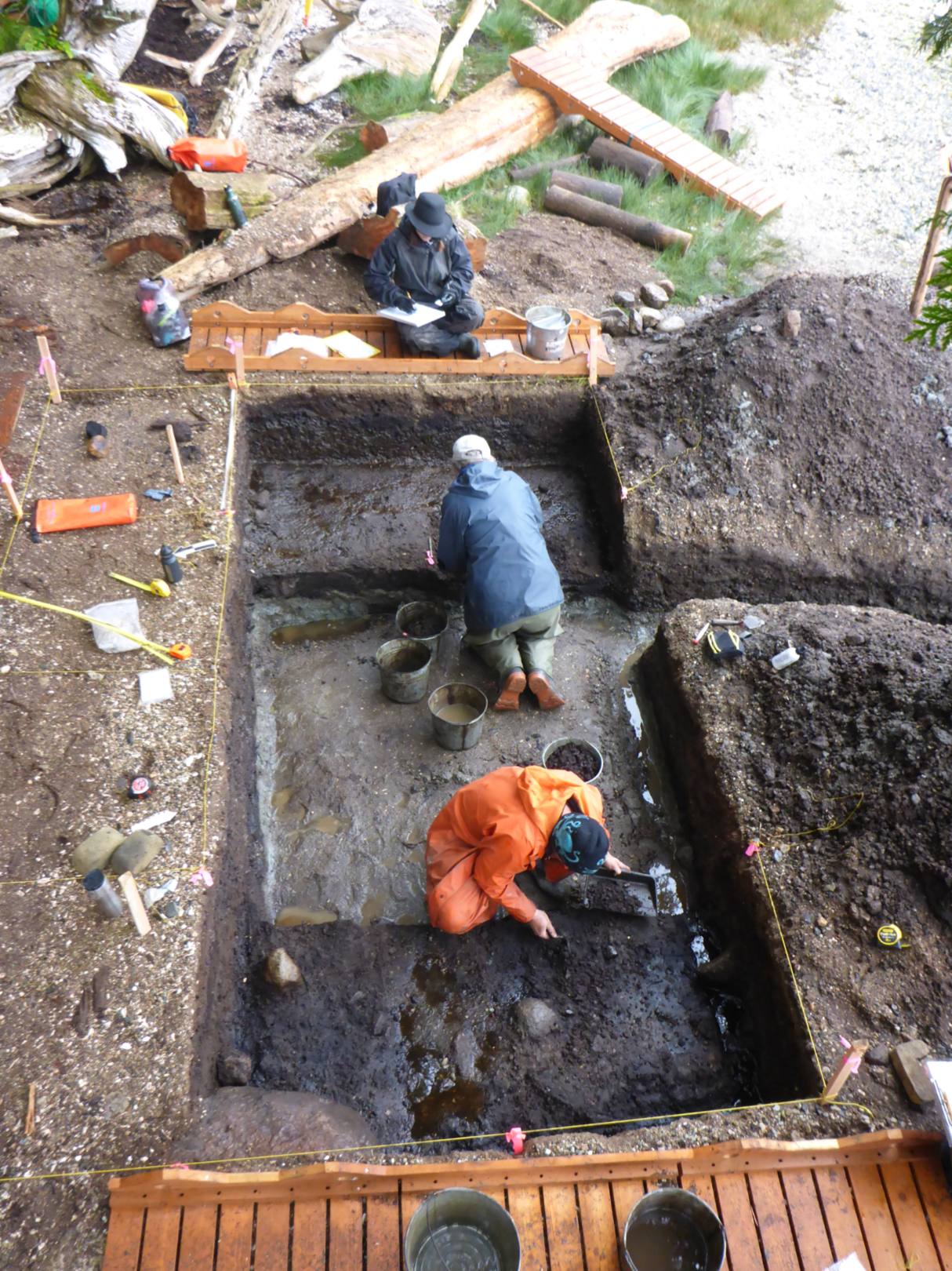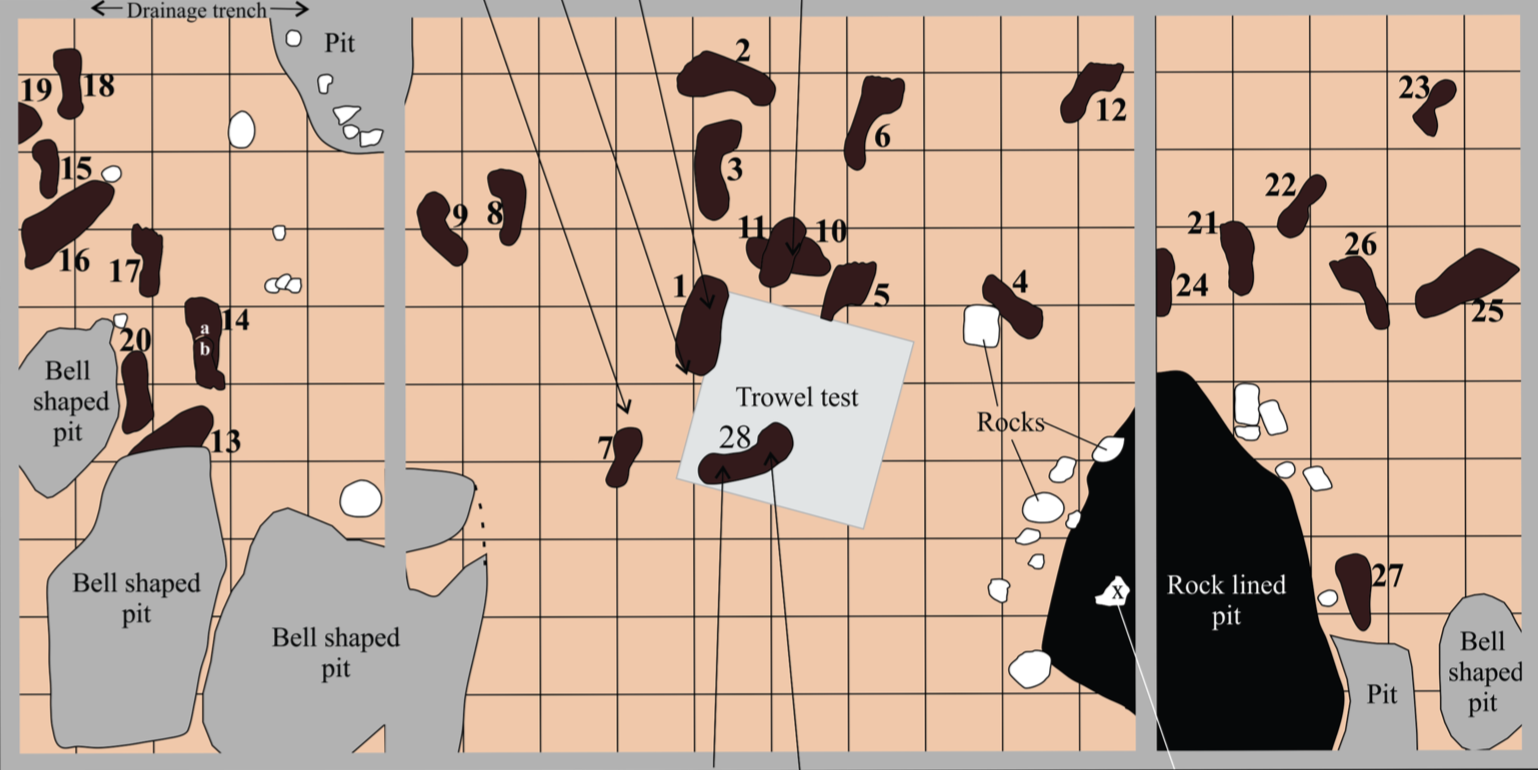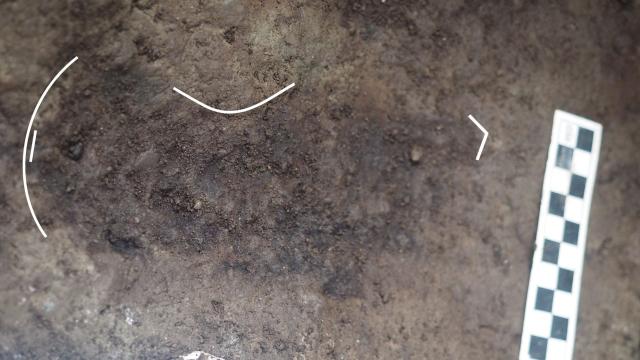Archaeologists working off Canada’s Pacific Coast have found 29 human footprints dating back to the end of the last Ice Age. The buried impressions were found along a beach – a discovery that’s bolstering the case for a coastal migratory route into North America.
One of the 29 footprints found in British Columbia. Photo: Duncan McClaren
When archaeologists are on the hunt for evidence of ancient human activity, they tend to find hardy things such as bones, stone tools and cave art. Finding the preserved remains of human footprints, on the other hand, is exceptionally rare. New research published this week in PLOS One describes the discovery of 29 human footprints found buried on the shoreline of Calvert Island in British Columbia. Dated to around 13,000 years old, the impressions offer potential proof that America’s first migrants travelled along the Pacific West Coast when the continent became accessible at the end of the last Ice Age. But because ancient humans had already taken root in North America by this point in history, more evidence will be required to bear this out.
During the last Ice Age, a massive chunk of ice called the Cordilleran Ice Sheet created a natural and impenetrable barrier between Eurasia and North America. When this obstruction finally melted some 16,000 to 15,000 years ago, it opened the gates to North America, allowing humans to venture from Siberia and Beringia into the continent. Owing to a dearth of archaeological evidence, however, archaeologists aren’t entirely sure about the routes taken by these venturous humans.
A popular and longstanding theory among many scientists is that the first Americans followed big game herds along a narrow, ice-free corridor that opened up in North America as the glaciers retreated. In recent years, however, an alternate theory has emerged, one known as the Coastal Migration Theory, or the Kelp Highway Hypothesis. According to this view, the first Americans migrated along the Pacific West Coast, travelling along the shorelines of what is now Alaska and British Columbia. It’s even possible that North America’s first settlers used boats, skimming the shoreline as they steadily moved south and eventually into the continent’s interior.
This theory makes a lot of sense; the ocean is a reliable source of food, and much of North America was still covered in massive glaciers at the time; according to some estimates, the ice-free corridor became habitable and human-friendly around 12,600 years ago, which is about 2000 to 3000 years after the coastline opened up.

A photograph of one of the footprints found (left) and a digitally enhanced version (right). Image: Duncan McClaren
The Coastal Migration Theory sounds great, but direct archaeological evidence to support it is scant. That’s why archaeologist Duncan McLaren, and his colleagues from the Hakai Institute and the University of Victoria, decided to dig around the intertidal zone of a beach on British Columbia’s Calvert Island in search of clues. At the dawn of the Holocene Era, sea level in this area was about 2-3m shallower than what it is today. The researchers were hoping to find physical artefacts and relics dating to the period between 14,000 to 10,000 years ago – but instead, they unexpectedly found 29 human footprints in an area measuring 4x2m.

This is pretty wild, because ancient footprints have only been discovered in three distinct places in the Americas, namely Argentina (dated at 14,000 years old), Chile (14,600 years old), and Mexico (two pathways, one dated at 10,700 years old, the other at 7200 years old).
The prints were found pressed into a layer of paleosol (former soil preserved underneath sediments) that was radiocarbon dated to between 13,317 and 12,633 years ago. Wood samples taken from the same stratigraphic layer were used for the dating. Detailed measurements and photographic analysis suggested the prints were made by three individuals, two adults and a child. The presence of toe prints indicates these people were barefoot when the impressions were made.
“The footprints were impressed into a soil just above the paleo-shoreline, possibly by a group of people disembarking from watercraft and moving towards a drier central activity area to the north or northwest,” write the researchers in the study, adding that the discovery adds to the “growing body of evidence that humans inhabited the Pacific coast of Canada during late Pleistocene times”.

Map of the site with footprints indicated. Image: Duncan McClaren/PLoS One
Ben Potter, an archaeologist at the University of Alaska Fairbanks who wasn’t involved in the new study, likes the paper, saying it helps us understand the antiquity of northern coastal occupations, but it doesn’t radically change our understanding of the initial colonisation of the Americas, nor does it add to evidence supporting a coastal migration that would have taken place thousands of years earlier.
“It would push evidence of Northwest Coast human occupation back about 400 years, but it still postdates the widespread occurrence of Clovis populations throughout North America around 13,500 to 12,900 years ago, and the earliest interior Beringian materials at 14,300 years ago,” he told Gizmodo. By Clovis populations, Potter is referring to a prehistoric culture known for their projectile points.
Anthropologist Gary Haynes, who works out of the University of Nevada, says the authors did “everything they could to record the site”, agreeing that the impressions “look just like human footprints and nothing else”.
“That said, the footprints are impressed into a an old sediment surface from which radiocarbon dates were taken at the base of the footprint impressions — which could mean the tracks are younger than the underlying surface by some unknown factor,” Haynes told Gizmodo. “Also, inconsistent dates in an overlying sediment layer suggest disturbance, perhaps from barefoot people walking in the sand.”
Haynes thought it was interesting that the youngest possible date of the footprints was placed at 12,633 years ago, which is within the range of Clovis archaeological sites, and in fact younger than some Clovis sites. “This evidence does suggest that humans were present on the western North American coast around the time of Clovis elsewhere in the continent,” he said.
As these scientists point out, the new evidence isn’t earth-shattering, but it does fit in rather nicely with what we already know, or at least suspect, about how and when North America was colonised. It’s further proof that ancient humans occupied the northern west coast at this early stage (a few hundred years earlier than previous estimates, as Potter pointed out), albeit a few thousand years after the first wave of migrants flowed into to the continent. The next challenge for archaeologists will be to find more, and older, archaeological evidence along the west coast to bolster the Coastal Migration Theory even further.
[PLOS One]
